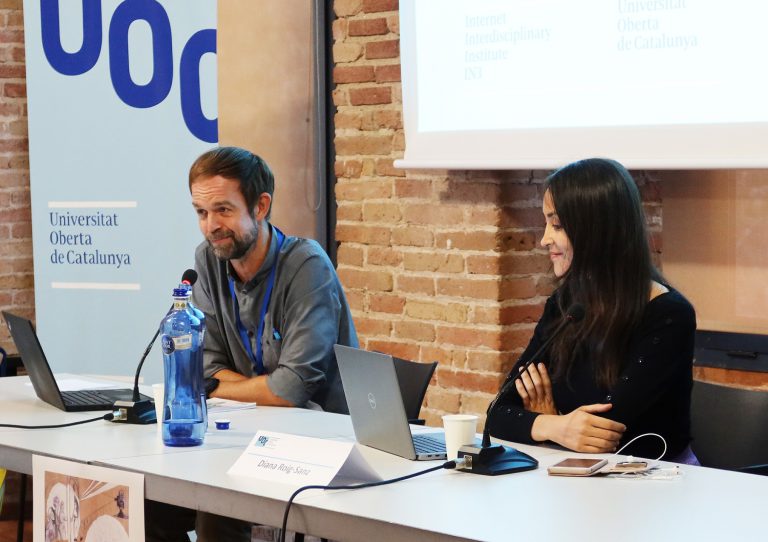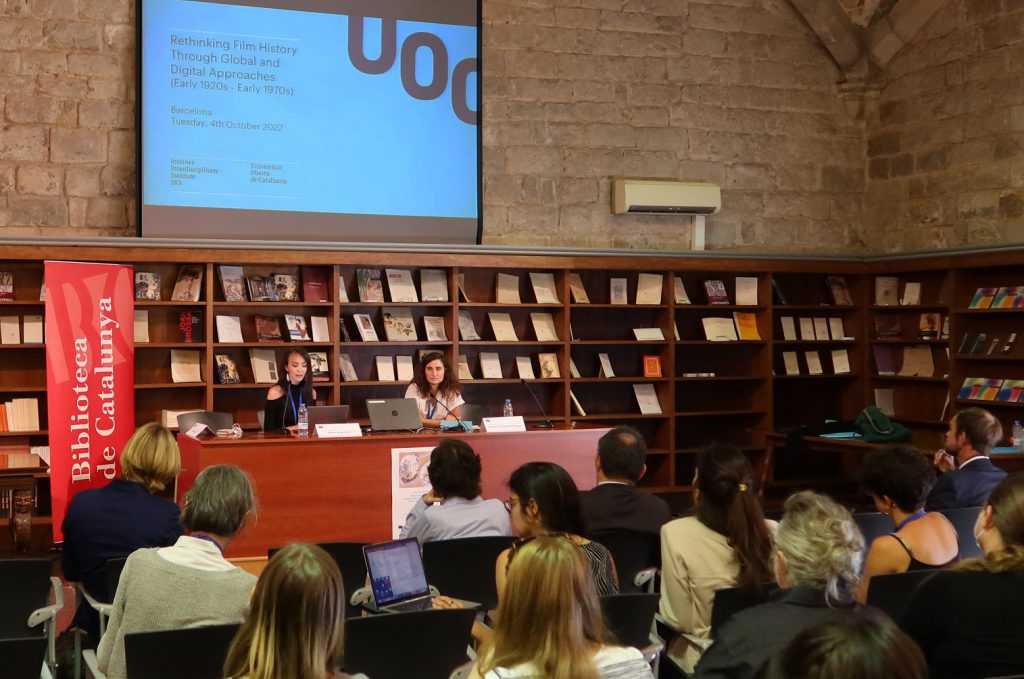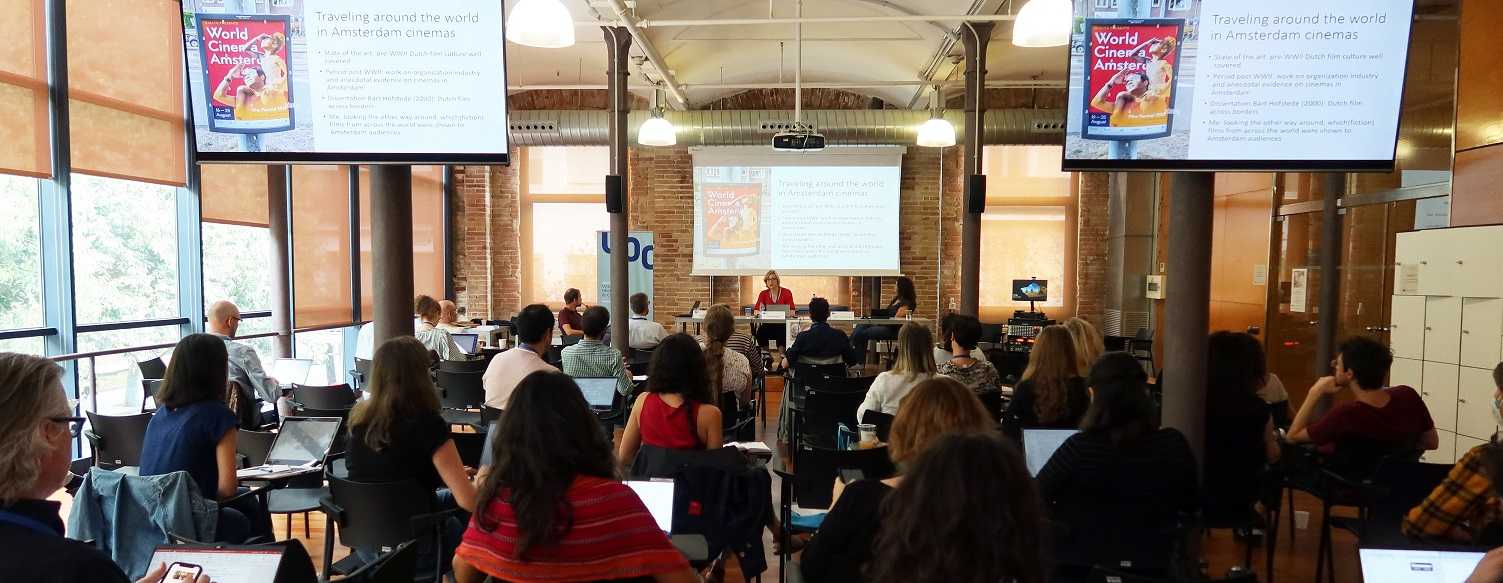Rethinking Film History. Global, Digital and Gender Perspectives
15 November, 2022 Image of the conference “Rethinking Film History through Global and Digital Approaches” with Malte Hagener and Diana Roig-Sanz.
Image of the conference “Rethinking Film History through Global and Digital Approaches” with Malte Hagener and Diana Roig-Sanz.A decentralized, global film history
There is certainly room to consider global perspectives in film studies and, more specifically, in relation to how global and digital approaches can help us to rethink film history. This was the main goal of the conference “Rethinking Film History through Global and Digital Approaches (Early 1920s – Early 1970s)”, which took place in Barcelona from 4 to 7 October 2022.
The conference aimed to contribute to a decentralized, global film history by offering theoretical insights and case studies on lesser-known actors, whom we understand as cultural mediators (Roig-Sanz & Meylaerts, 2018). As part of our goal to apply a global and decentralized perspective to film cultures, we also introduced a gender perspective, stressed the role of the Global South (Latin America specifically) and paid attention to scales beyond national frameworks. Of course, when discussing the idea and definition of “the global” as a way of rethinking film and cinema history, we must point out two other (sometimes overlapping, other times opposing or conflicting) terms: transnational cinema and world cinema.

Following in the footsteps of Robert Stam (2019), the conference advocated interdisciplinarity – borrowing concepts, terms and methods from neighbouring disciplines such as comparative and world literature, as well as from anthropology, sociology and computer science, especially if we adopt a data-driven approach and deploy digital tools in film history. The organizers of this scientific meeting, which was supported by the European Research Council, the Global Literary Studies Research Lab at the IN3-UOC, the Marburg Center for Digital Culture and Infrastructure, and Filmoteca de Catalunya, embraced the premise, as a conceptual starting point, that no single film culture travelled from a specific center to the peripheries. Quite the contrary, we advanced the hypothesis that many film cultures developed at the same time or in a short time span, and they all came together, competed, mirrored or ignored each other.
Within the framework of Dona Haraway’s situated knowledges and partial perspective, we envisage our research as being ever relational, never fixed, and open to redefinition and constant change. In this regard, we observed a willingness to map a totality (in Jameson’s terms) – all-encompassing, a sense of how everything is connected, yet at the same time beyond representation and always eluding us, slipping away.
The conference also shed light on the discussion around controversial terms such as “Third World”, “Global South” and “postcolonialism”, and raised the question, how do we reach a form of objectivity that is plural and collective? From where are we talking and arguing? As Haraway (1988) pointed out, “situated knowledges are about communities, not about isolated individuals. […] Its images are not the products of escape and transcendence of limits (the view from above) but the joining of partial views and halting voices into a collective subject position that promises a vision of the means of ongoing finite embodiment, of living within limits and contradictions – of views from somewhere” (p. 590).

In this respect, it is also worth acknowledging the place of New Cinema History, in which the mapping of screening-sites/cinemas is being complemented by personal memories and remembrances. Of course, this is a dialectic relationship that is impossible to break or solve in any definite way, and one can only move back and forth without ultimately fixing oneself in a single position. Would non-alignment be a principle of research?
Key concepts
The conference also dealt, either directly or indirectly, with five concepts which are key in any global approach to any discipline (Roig-Sanz & Rotger, 2022): space, time, agency, scale and connectivity. These terms help us to identify what we found most surprising or new, what the recurrent questions or concerns were, and which debates were most significant.
1. Space
Our conference participants presented compelling cases in very specific spaces, e.g. formal and informal cinemas (outdoor movie screenings). They also spoke on broad ideas of space, e.g. “geographies of film consumptions”; different media to convey space, e.g. maps, photos, floor plans and abstracted graphics; and distance as something that can be measured, but is at the same time mental and imaginary. Likewise, this concept may also point to the archive space, a concrete place where researchers go and a way of organizing material (see the presentation by Sofia Sampaio) or a machine of power and control that oversees knowledge access and production (Guilherme Machado); new attention to places that were off the map for the longest time, e.g. postcolonial areas, the Global South, Latin America and Africa (see the research by Jonas Van Mulder, Mario Slugan, Rahul Kumar, Maria Luna-Rassa and Miguel Errazu); or communities such as the LGBTIQ+, as in the research by David Morton.
2. Time
Our conference focused on history, which implies placing temporality at the core. Valeria Camporesi, one of our keynotes, referred to the histoire de temps present, but we could also think of new cinema history and what it means to have, for example, periodizations of 10-year cross sections. There is also the time span covered by our conference – from the early 1920s to the early 1970s – defining and implementing time spans as methodological premises. Every historical-hermeneutical investigation necessarily proposes a certain time interval as relevant which can also be contested.
3. Agency
It was quite telling that we hardly had any presentations focusing on only one mediator. Rather, the focus was more set on the role of women (data feminism, as in the case study by Ainamar Clariana-Rodagut and Alessio Cardillo) and gender, more generally, as in the case by Dalila Missero, who studied global feminist film networks in the late 1970s. Attention was also paid to the role of journals and magazines (Anna Torres-Cacoullos, Georgina Torello, Fabio Andreazza, Marta García Carrión, Elena Solbes Borja and Ecem Yildirim). Indeed, to whom do we assign agency, humans alone or also things and ideas? An anthropocentric sociology or actor-network theory, still focusing on stuffness and materiality – what about affects and emotions?
Agency was also related to institutions or communities of practice (a term from cognitive ethnography). This was the case of researchers working on film clubs (Gabriel Rodríguez, Alexander Donev, Konrad Klejsa, Michael Cowan and Rielle Navitski), but also us as a group that has been formed over the last few days. This may allow us to ask ourselves if we are moving towards a flat ontology in which we steer away from the subject as the centre of our universe.
4. Scale
The idea of scale showed us that we are not only referring to micro-, macro- and meso-level scales, but also that we have to move beyond pure formalism (Selin Yagci and Natalia Cantó’s reading of Velazques’ painting Las meninas via Michel Foucault’s seminal interpretation). How far away are we from our object of study? And how can we approach a multi-sided and situated object of study without imposing a formal framework that remains external to the object? The idea of scale was also perceived in the talk given by Daniela Treveri Gennari, who presented the European Cinema Audiences project. This collaborative research has a transnational perspective and takes secondary cities in the UK, Italy and Belgium as its points of departure.
5. Connectivity
Finally, the idea of connectivity allowed us to talk about networks, both in a keenly mathematical sense (nodes and edges, computation, number of connections, as in the talk by Julia Noordegraaf) and in a social sense (activism, gender, collaboration) – Masha Salazkina, Stefanie Van de Peer, Nicole Braida, Isadora Campregher and Imme Klages. Digital approaches were also applied by Philippe Meers and his analysis of historical cinema cultures in Latin America and by Mila Oiva and Helena Hanna Juht, who explore newsreels in the case of Estonia. Yet again, how do we go from data to multi-sided, complex statements about reality? What are networks and their visualizations? Are they representations of reality or constructions of data? How does the presence of network theory transform the way we think about what we do? Methods, tools and theories are never completely neutral, always interfering in our ideas and imaginations.
Future challenges
In short, the conference gathered in Barcelona representatives from a wide range of academic affiliations and geographical areas in the Americas (Mexico, Colombia, Argentina, Uruguay, Chile, Brazil, Canada and the United States), Europe (Germany, the United Kingdom, Belgium, Flanders, the Netherlands, Italy, Finland, Poland, Portugal, Russia, Estonia, Bulgaria, Croatia, Lithuania, Turkey [online], Spain and Catalonia) and India [online].
Participants were mostly cultural historians and researchers from media studies and communication departments, but also literary and translation scholars and colleagues from data science and physics. In this respect, the conference stressed the huge potential of transdisciplinarity, interdisciplinarity and collaboration. It also brought to the fore, within a gender perspective, the coincidence of the global and the digital in a new sense of how things are connected and interdependent. Thus, we searched for patterns and structures rather than meaning and ideology. Our participants described the methodological challenges of working with data models and OCR, digital infrastructure and visualization programs such as Gephi.
In this regard, it is fair to acknowledge that these are only tools, in the sense of techniques, and not necessarily new methods, which is an important distinction. Is our research tool-driven, data-driven or question-driven? Do we do something just because we have a data set available or a new tool to toy with? What does it mean if we start doing network analysis more out of curiosity about the method than out of a research necessity?
The conference left room to discuss relevant issues in data-driven research such as the question of openness (open science, open access, open source, open peer review, but also open exchange, open borders, etc.); interdisciplinarity and transdisciplinarity; collaborative work and mixed teams (data science, archive work and being an expert in our field); mixed methods (digital and hermeneutical); and scholarly-led, scholarly-owned, take back the streets and transformed valuation of work (on data), collaboration, social justice and authorship.
Yet again, these ideas should not become a dogma because other communities might have different notions of who owns data or knowledge. (There must be constant dialogue with those who have generated/owned specific data.) Still, we believe it is good to follow them as a rule of thumb. Certainly, digital tools are not methods in themselves. They can help us to rethink what we do, but they should usually be part of a larger shift in how we undertake our research.
Finally, we may also point out the question of aesthetics. As Robert C. Allen and Douglas Gomery (1985) wrote in Film History: Theory and Practice: “For certain investigations, film viewing is really an inappropriate research method. […] Films themselves tell us next to nothing about modes of production, organization structures, market situations, management decision making, or labor relations, just as close examination of a bar of soap would reveal little data in the study of the personal hygiene industry” (p. 28). We wonder if much has changed or if this has been intensified. What is the role of the aesthetic in digital methods? How can we employ machine learning methods of object and face recognition, of shot scale and editing?
There is no doubt that our ways of working are rapidly changing. More than our methods, our practices are being transformed. In fact, with the internet and the pandemics, with the Anthropocene, climate change and flight shame, we have already modified our working practices much more than we realize. The conference certainly covered a lot of ground, but we still need to reflect on the impact of these significant milestones and work on what is missing and what the gaps are. Do we still have a small sense of the planetary, the environmental or the Anthropocene? Isn’t nature our new culture in the sense that we now inhabit a world in which even what we call nature has been shaped by humans? How does the deep time of extractivism and the restructuring of the environment by human hand relate to the relatively short time (130 years) of cinema? Where do we go from here and how do we continue?
“Rethinking Film History through Global and Digital Approaches (Early 1920s – Early 1970s)” gave us lots of food for thought and brought together researchers who may not have realized that they were working along the same lines. In this respect, we are certain that we have helped to lay the foundation for more global, decolonial, digital and gender perspectives in film and cinema history.
Malte Hagener is professor in Media and Film Studies at Philipps-Universität Marburg. He received his PhD with a dissertation on the European film avant-garde (Moving Forward, Looking Back. The European Avant-garde and the Invention of Film Culture, 1919-1939, Amsterdam UP 2007). Co-author (with Thomas Elsaesser) of Film Theory. An Introduction through the Senses (Routledge 2010, 2nd ed. 2015). Editor of The Emergence of Film Culture. Knowledge Production, Institution Building and the Fate of the Avant-garde in Europe, 1919-1945 (Berghahn 2014, Limina price). He is the co-organizer of the international conference “Rethinking Film History through Global and Digital Approaches (Early 1920s – Early 1970s)”.
Diana Roig-Sanz is an ICREA full professor at the Internet Interdisciplinary Institute of the Universitat Oberta de Catalunya (IN3-UOC). She is the coordinator of the Global Literary Studies Research Lab (GlobaLS), principal investigator of the ERC Starting Grant project “Social Networks of the Past. Mapping Hispanic and Lusophone Modernity, 1898-1959”, and has co-organized the international conference “Rethinking Film History through Global and Digital Approaches (Early 1920s – Early 1970s)” together with Malte Hagener, Ainamar Clariana-Rodagut, Ramon Balcells and Pablo Suárez-Mansilla.





